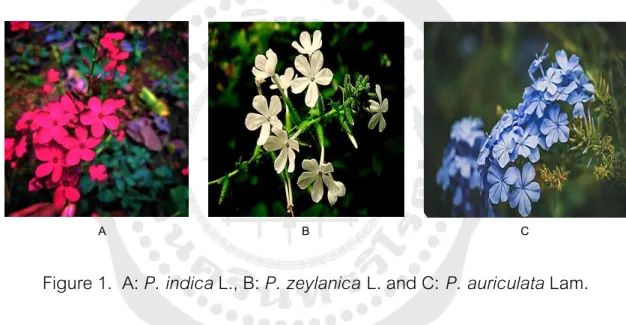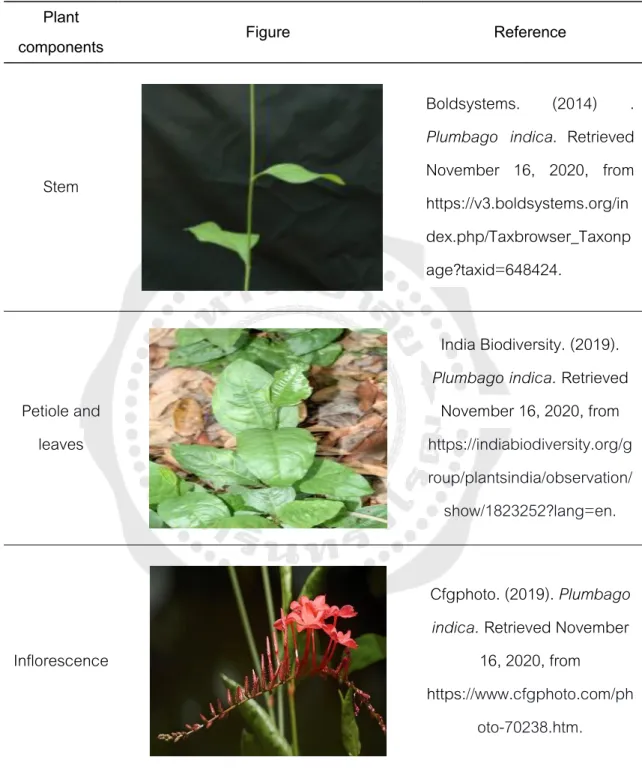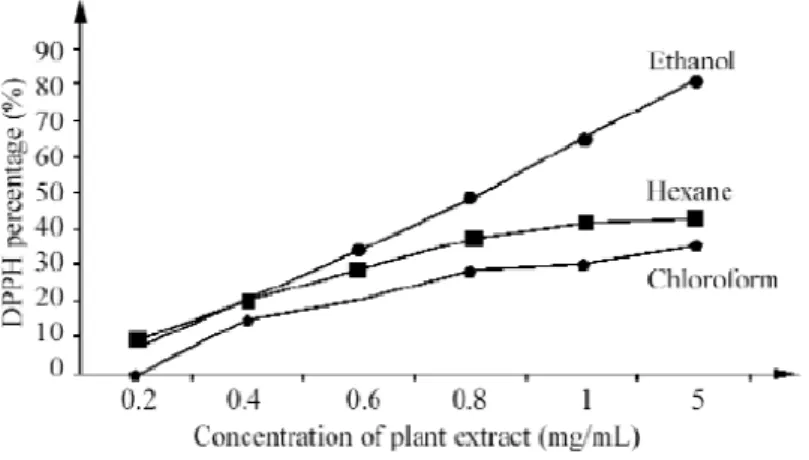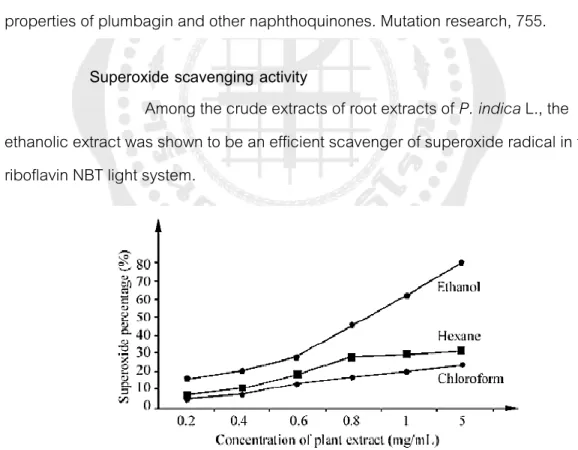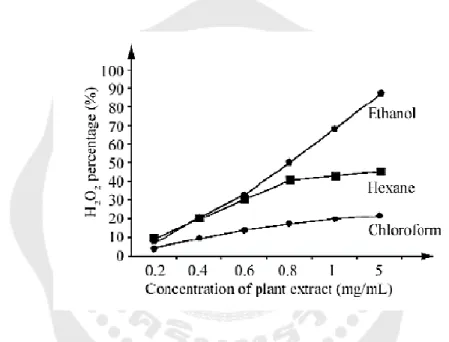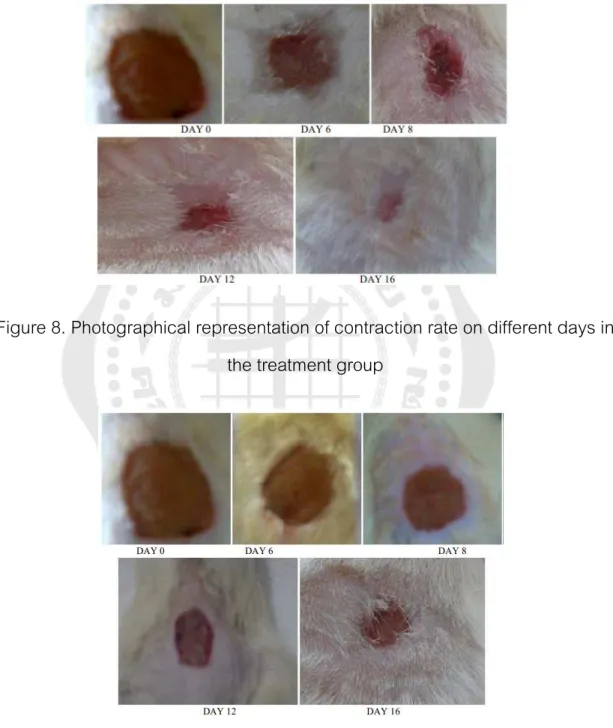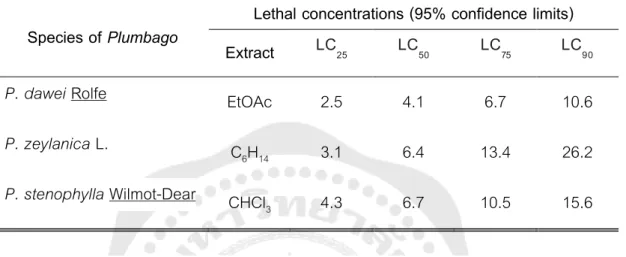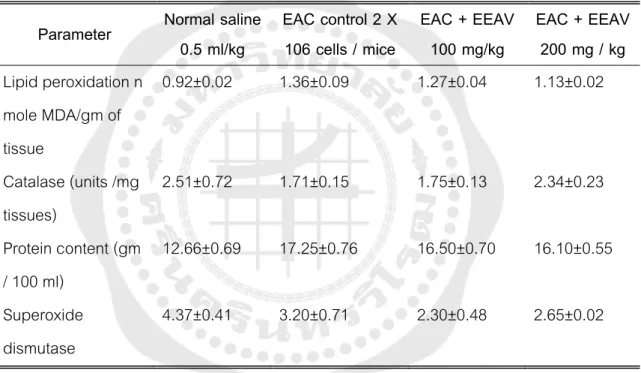A thesis submitted in partial fulfillment of the requirements for the degree of MASTER OF SCIENCE. HAS BEEN APPROVED BY THE SCHOOL OF RESEARCH IN PARTIAL FULFILLMENT OF REQUIREMENTS FOR THE MASTER OF SCIENCE. Plumbago indica L., known as Chettamuun Phloeng Daeng, is a medicinal plant belonging to the Plumbaginaceae family.
The study aimed to isolate, separate and evaluate the antifungal activities of compounds from the branches of P. Six constituents, plumbagin (1), β-sitosterol (2), maritinone (3), 7,7´-biplumbagin (4), cis -isoshinanolone (5) and trans -isoshinanolone (6), are from the branches of P isolated. This study is the first time to report the isolation of compounds maritinone, 7,7´-biplumbagin and trans-isoshinanolone from P.
I am privileged to express my words of gratitude to all my well-wishers, teachers, friends and professors who have encouraged and inspired me to complete all my work related to my degree of Master of Science. Finally, I would like to express my deepest gratitude to my family and friends for their support and understanding.

INTRODUCTION
The red petals are divided into 5 lobes, while the leaf blade is narrowly oblong to elliptic-oval in shape and measures 5–15 cm by 2–8 cm (Priyanjani et al., 2021). In Indonesia and Malaysia, a root and leaf poultice is used as a pill for toothache (as an anti-irritant), paralysis, rheumatism, leprosy, swollen glands and tumors. Similarly, these slices can also be applied on the forehead to prevent headaches (Priyanjani et al., 2021).
Preferably, the roots have many uses, they are stimulant, pungent, digestive, laxative, alterative and a powerful oral contraceptive and abortifacient. The roots are used to make an ointment by mixing with vegetable oil, it is used to keep headache and rheumatism. The roots and bark are astringent and carminative, making them suitable for keeping dysentery, intestinal problems, dyspepsia and diarrhea (Batugal et al., 2004).
Medicinal preparations from the roots of this plant are pungent and astringent and confirmed to have carminative, anti-inflammatory, thermogenic, abortifacient, anthelmintic, antiperiodic, nerve stimulant, digestive and rejuvenating properties (Joy, 1998). The crude extract of this plant has been reported to exhibit a wide range of biological activities such as antibacterial (Paul, 2014), wound healing (Karthikeyan et al., 2013), antifertility (Sheeja et al., 2009a), hepatoprotective (Eldhose). & Kuriakose, 2017), antioxidant (Karthikeyan et al., 2013), anti-helicobacter pylori and anticancer activities (Hiradeve et al., 2011; Saha & Paul, 2012).
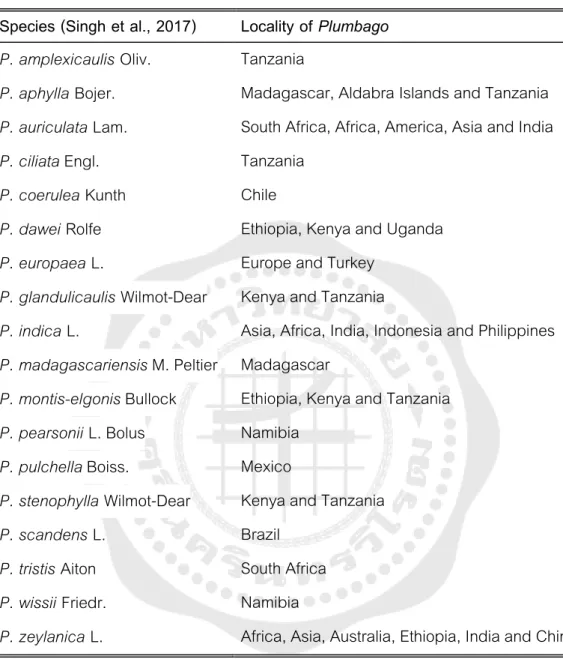
LITERATURE REVIEW
Crude extracts (petroleum ether, chloroform, acetone and methanol extracts) of P. rosea L. were tested for antifertility activity. Studies showed that the acetone extract of the stem of P. rosea L. had the function of antifertility, while all the remaining sections were inactive compared to the control, 2009b). This activity may be due to the presence of naphthoquinones and flavonoids in the acetone extract of P. Estrogenic and antiestrogenic activity of acetone extract.
Effect of different doses of ethanol extract of P. on various biochemical parameters in mice bearing EAC. In 2008, the anti-inflammatory activity in Wistar rats was investigated with a phosphate buffer saline extract of the roots of P. pH 7.2). In 2010, crude methanol extract and water extract of P. root were evaluated for antipruritic activity using p-hydroxybenzoic acid and normal saline as positive and negative controls.
Anti-sickle effect (% inhibition of sickle) of methanol and aqueous extract of the root of P. Determination of LC50 and LC90 Methanolic extract of P. TC = test column, LC = lethal concentration, MEAC = methanolic extract of P. Cytotoxic activity of methanol extract from Plumbago indica L. Asian Journal of Pharmacy and Technology, 59-61).
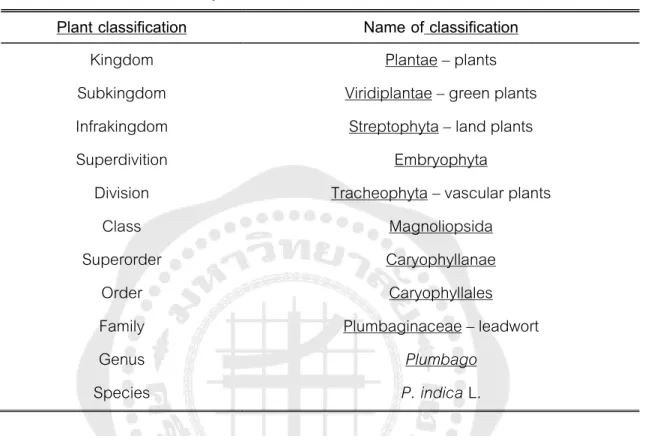
RESEARCH METHODOLOGY
2 Packaging strategy: Slurry packaging for silica gel 60 particles between 0.040 and 0.063 millimeters in size. 2 The sample is not dissolved in the solvent system: The sample has been dissolved in a small volume of a suitable organic solvent. The mixture solution will include silica gel particles of mm size.
Using a rotary evaporator (BUCHI, Thailand), the sample will be evaporated at a reduced pressure before being added to the top of the column. 4 Elution: After loading the sample onto the column, the appropriate solvent solution will be used as the mobile phase. In gradient systems, starting with the least polar solvent system, elute the sample, then progressively increase the polarity of the solvent system, and in isocratic systems, the composition of the mobile phase remains constant throughout the isolation.
The plant material was successively extracted with different organic solvents in increasing order of polarity at room temperature. The resulting residue (Marc) was extracted with ethyl acetate and methanol, respectively, with the same procedure as dichloromethane extraction. Evaporation of the filtrate under reduced pressure (ca. 45°C) gave CH 2 Cl 2 extract, EtOAc extract and 20% H 2 O:MeOH extract.
The CH2Cl2 extract was subjected to silica gel (CC) column chromatography using a hexane-EtOAc gradient (10:0 to 3:7) to obtain 10 fractions (C1-C10). The structure of the isolated compounds will be elucidated by spectroscopic techniques such as nuclear magnetic resonance (NMR) spectroscopy and mass spectrometry. The isolated compounds were diluted to obtain 20 µL of 0.25, 0.5 and 1 mg and then streaked onto a paper disc placed on a plate containing the target fungi.
The antifungal activity of each extract on the fungus was measured after incubation for 3 days at 28 °C and presented as the diameter of the zone of inhibition.
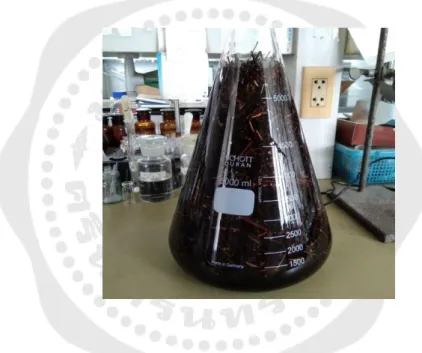
RESULTS AND DISCUSSION
The structure of 2 was thus identified as a steroid by comparing its spectroscopic data (1H and 13C-NMR) with those reported in the literature (Chaturvedula, 2012) and was named. The structure of compound 3 was characterized by analyzes of the 1H, 13C, DEPT, 1H-1H COSY, HSQC and HMBC spectroscopic data. The HSQC spectrum helped to assign the attached protons to their corresponding carbon atoms, while the 1H-1H COZY spectrum demonstrated the partial structure of H-6 to H-7.
A comparison of the NMR spectral data between compounds 1 and 3 revealed similarities, but the splitting model for H-6 and H-7 was simplified due to the absence of H-8, which placed the dimer bond at C-8 with C -8 , suggesting that compound 3 was a dimer of compound 1 and was further supported by the mass spectral data of compound 3. The structure of compound 3 was identified as 8,8'-biplumbagin by spectroscopic methods (1D and 2D -NMR) including a comparison with data reported in the literature (Gu et al., 2004) and was named maritinone. 1H and 13C-NMR spectral data showed only 11 carbon signals and proton signals corresponding to a plumbagin (1).
However, the mass spectrum and molecular formula both showed 22 carbons, indicating that compound 4 is a symmetrical dimer of plumbagin. NMR comparison of compound 4 with compound 1 revealed that an aromatic proton, H-7, in compound 1 (H 7.60) was missing. The double proton signals at H-6 and H-8 in compound 1 were replaced by single protons at H-6 and H-8 in compound 4 .
1H-1H COZY and HMBC spectra of compound 4, in combination with a comparison of literature data (Salae et al., 2010), led to the assignment of the proton and carbon resonances in compound 4. The relative configurations on C- 3 and C-4 can be suggested from the observed vicinal 1H-1H coupling constant (J = 2.4 Hz) between H-3 and H-4, indicating an axial-equatorial orientation of these protons, representing a 3,4- cis supports configuration. Therefore, the structure of compound 5 was identified as cis-isoshinanolone by spectroscopic methods (1D and 2D-NMR) including a comparison with data reported in the literature (Bringmann et al., 1999).
Comparison of the 1H and 13C NMR spectroscopic data with that of compound 5 revealed that compound 6 had a similar pattern except for the coupling constant (J = 2.4 Hz) between H-3 and H-4 in compound 5. Therefore , the structure of Compound 6 was identified as trans-isoshinanolone by spectroscopic methods (1D and 2D-NMR) including a comparison with data reported in the literature (Bringmann et al., 1999). Antifungal activity of isolated compounds and crude extracts was measured by an inhibition zone assay against clinical isolates of pathogenic fungi which are A.
The linkage between positions 8 and 8 of plumbagin in compound 3 resulted in significant loss of antifungal activity.
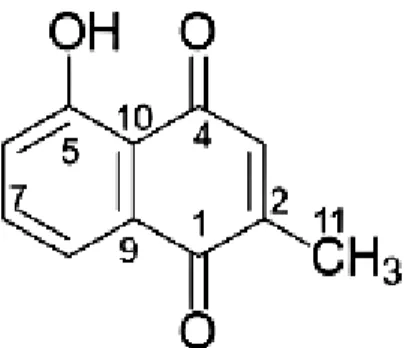
CONCLUSION
Antifungal activity of Indian medicinal plant essential oils against human pathogenic Aspergillus fumigatus and A. Cytotoxic and antimicrobial constituents of the bark of Diospyros maritima collected from two geographical locations in Indonesia. Comparative biochemistry of the flavonoid IV.: Correlations between chemistry, pollen morphology and systematics in the family Plumbaginaceae.
Plumbagin inhibits tumor angiogenesis and tumor growth through the Ras signaling pathway following activation of VEGF receptor-2. Plumbagin promotes the formation of astrocytes from rat spinal cord neural stem cells via activation of the transcription factor Stat3.
